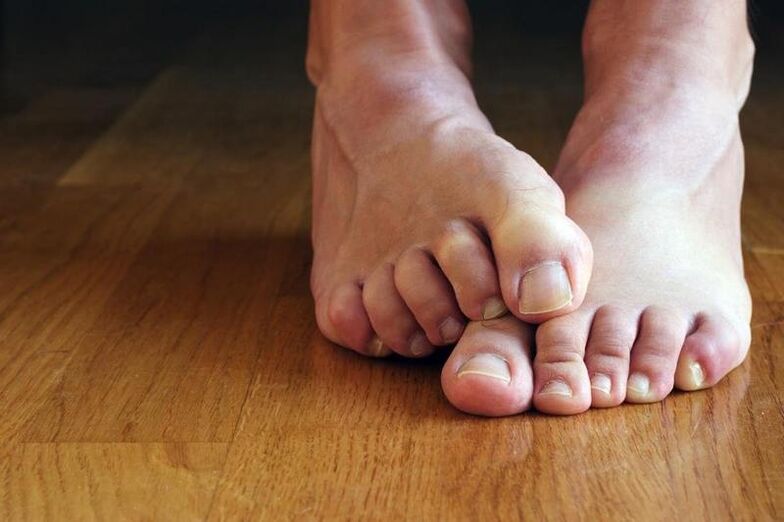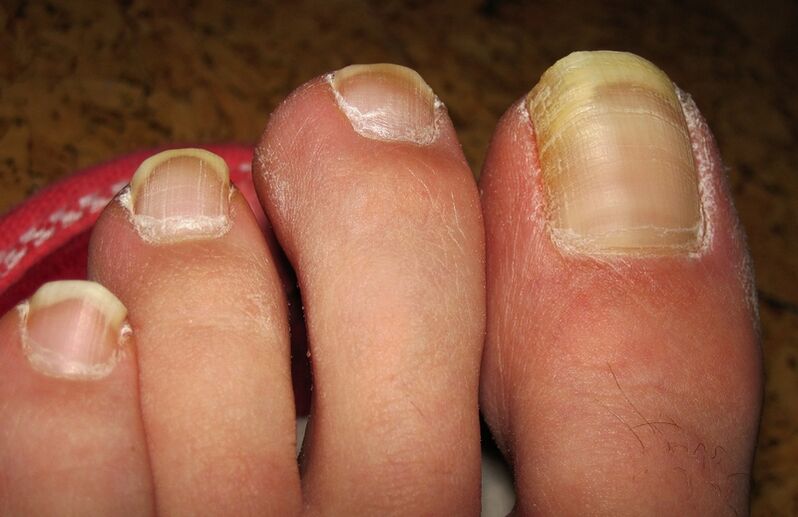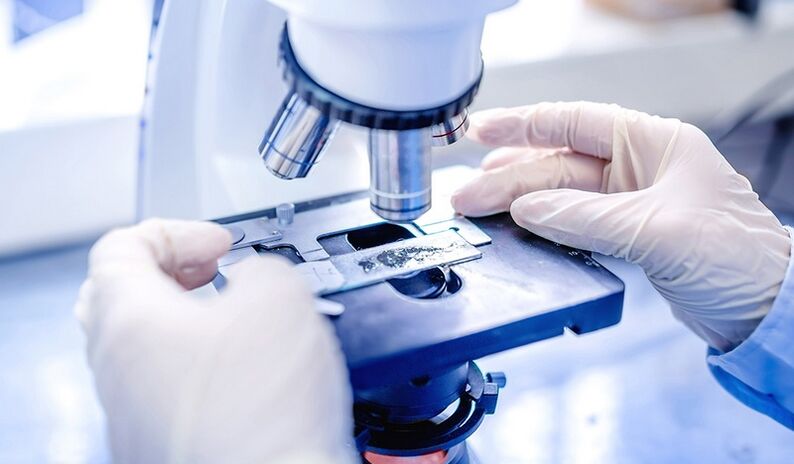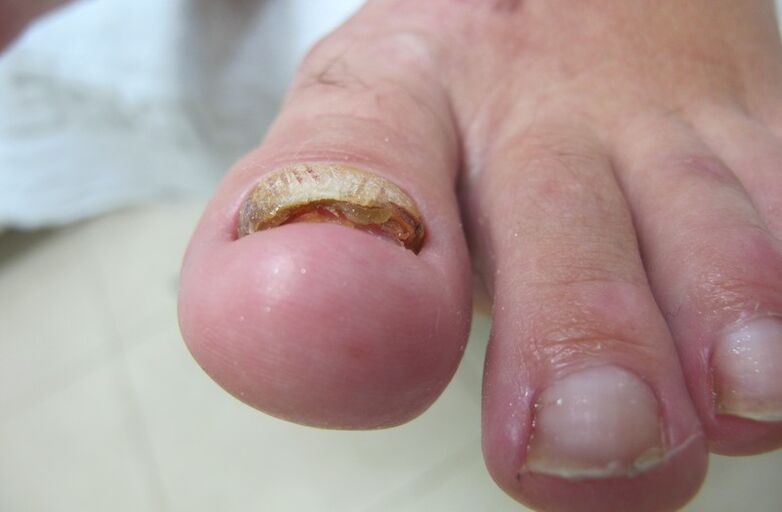Fungal diseases of the toenails are quite common in humans. In addition to the undesirable cosmetic effect, these infections can cause significant damage to the body, so onychomycosis must be treated. But for this you need to know as much as possible about this disease, especially since today scientists have identified a large number of types of pathogens.
types of pathogens
With onychomycosis, parasites begin in the structure of the nail tissue and in the skin around them. According to the generally accepted classification, spore microorganisms that can manifest themselves in humans are divided into three groups:
- yeast nail fungus, mainly Candida albicans;
- dermatophyte fungi (genus Trichophyton, Microsporum and Epidermophyton);
- Types of mold (genus Aspergillus, Alternaria and Fusarium).
Acute or chronic onychomycosis causes each of them separately. It is also not uncommon for two or more rarely three of these species to be infected at the same time. When diagnosing, it is extremely important to accurately detect the causative agent, since each of the groups of fungal diseases can be treated with different, non-universal drugs.

Reasons for appearing
The reasons for the development of infection can be associated both with the penetration of the pathogen from the external environment and with the general condition of the patient's body. Your knowledge will help you understand how to treat nail fungus.
External sources of fungal spread include:
- Swimming pools, changing rooms, showers, baths - those public places where a person walks barefoot. Therefore, slippers should be worn when visiting such facilities for safety reasons.
- The use of poorly disinfected tools in beauty salons during a pedicure, which can be dangerous for the body in general.
- Other people's files, scissors and other personal care products are no less dangerous.
- In the summer, closed-toe shoes can pose a hazard, in which the feet sweat profusely.
- In order not to treat onychomycosis of the nails, you should bathe or shower regularly, since sweat and dirt are a favorable environment for germs.
- Some types of onychomycosis are transmitted by domestic animals, but such pathogens are common mainly in hot countries.
Other health problems also contribute to the development of the disease described:
- weakened immune system.
- The presence of small wounds and cracks on the skin, dry tissue.
- A large number of ridges.
- Violation of blood flow to the nail tissue.
- Contact with fungal pathogens from human skin. This method of infection is called autoinfection.
Thus, there are many sources of infection with fungal diseases. These microorganisms are very common around the world, so a disease like nail fungus occurs in many people. So, knowing how to treat onychomycosis will never be superfluous.
symptoms and diagnosis
The appearance of a fungus on the legs does not mean the inevitable development of the disease. Onychomycosis develops only in a person with a weakened immune system. But there are many ways in which toenail fungus manifests itself. In this case, look out for the following symptoms of nail fungus:
- compaction or reduction in thickness of the stratum corneum;
- high fragility of the nail plate, its delamination;
- the presence of ridges and calluses;
- unnatural color: white, yellowish or greenish shades;
- roughness of the surface of the nail plate;
- loss of natural shine;
- inflammation of the skin of the fingers, itching in the feet;
- cracked foot.

These signs can help you figure out how toenail fungus starts.
Treating advanced toenail fungus is extremely difficult and lengthy. That is why the appearance of onychomycosis symptoms cannot be ignored. If they are found, you should immediately consult a doctor.
The main goal of diagnosing nail fungus is to accurately determine the causative agent of the infection. Many types of parasites are extremely difficult to recognize, especially since the external signs of the disease can easily be mistaken for metabolic disorders.
As a rule, onychomycosis is diagnosed in several stages, for which the following methods of detecting toenail fungus are used:
- study of clinical data;
- Analysis of a piece of tissue under a microscope;
- cultural diagnostics;
- DNA research.
During the examination of the patient at the first appointment, the doctor can diagnose the presence of damage to the nail plate. However, without accurate studies, it is not possible to understand what caused the disease. Laboratory tests are the only way to identify nail fungus.
By examining a scratch under a microscope, a doctor can tell you exactly what toenail fungus looks like. The difficulty lies in determining the specific type of pathogen. Therefore, the diagnosis does not stop at this stage.
The exact fungal culture is determined by growing them in the laboratory. For this purpose, a nail fungus analysis is carried out on the basis of a special Sabouraud nutrient medium. Usually after three to five days of such a study, specialists can determine the specific type of pathogen. Also, this method allows you to check the susceptibility of parasites to drugs and outline the most effective course of treatment.

Parasite DNA testing is the current and most promising option for identifying toenail fungus, reducing the time to get results to a day or two. However, such an analysis for nail fungus can only effectively detect the yeast species.
who is at risk
As previously mentioned, certain groups of people are susceptible to onychomycosis to varying degrees. The following factors increase the chance of infection:
- reaching retirement age. Due to reduced blood flow and deterioration in metabolism, this disease is much more common in older people than in other demographics. The late diagnosis also plays an important role, since pensioners who have discovered the symptoms of nail fungus and see it as a common sign of old age do not always seek qualified help.
- Mechanical damage to the nail tissue. Any injury impairs the supply of nutrients to the tissues. As a result, at the site of a break or crack, a focus of infection begins, which then spreads throughout the nail and can even simply fly out.
- High blood sugar levels damage the blood vessels in the foot. Therefore, the manifestation of onychomycosis in diabetics is so common that it is also extremely difficult for them to get rid of it.
- For exactly the same reason, diseases of the circulatory system such as Raynaud's syndrome or varicose veins can cause infection.
- Because spores can most commonly multiply on both nail tissue and the body surface, people affected by fungal infections of the skin are at risk of onychomycosis. Once defeated, a disease can reappear.

The danger of ignoring symptoms
Many people don't see a doctor when they find signs of a yeast infection, and take time to try to cure an advanced fungus. This is due to the relatively mild course of the disease and the possibility of concealing blemishes with socks or closed shoes.
However, you should not ignore the first symptoms and treatment of the disease, otherwise there may be serious complications.
If you are wondering why toenail fungus is dangerous, then you should start with the fact that onychomycosis is contagious. An infected person poses a danger to others.
Certain restrictions are imposed on patients with fungal infections. For example, a person with an old fungus will never be issued a medical certificate of admission to the swimming pool.
As a parasitic disease, toenail fungus weakens the patient's immunity and increases the likelihood of other health problems. Trying to cure nail fungus at home can lead to more serious problems.
Old onychomycosis leads to serious consequences that should be feared:
- Parasites can enter the circulatory system;
- lack of treatment for toenail fungus seriously weakens the immune system;
- Spores increase allergic reactions, aggravate chronic diseases;
- Due to the deterioration in general health, people are more prone to depression, insomnia and so on.

That is why the first signs of toenail fungus should be the reason to contact the clinic.
treatment
Toenail fungus treatment is based on two principles. First, drugs mechanically destroy spores. Second, drugs slow down the reactions of parasites, blocking their activity and reproduction. By the way, you should think carefully before you decide to treat nail fungus during pregnancy.
Medicines, folk remedies, laser treatment of nail fungus and medical pedicure are used in medicine.
Drugs from the pharmacy
Pharmaceutical products have a strong impact. Many of them are specially selected for specific pathogens, which further improves the effectiveness of treating nail fungus in children and adults. Of all the ways to cure toenail fungus fast, medication is the best.
To increase the effect, a diet against nail fungus can help. It is prescribed by the attending physician.
home remedies
Fighting parasites on your own is often unsuccessful, since fungi tend to restore the spore structure. Therefore, when the first signs of the disease are detected, it is best to consult a doctor. Only a doctor can safely suggest how to get rid of nail fungus quickly.
There are many ways that one can cure toenail fungus. Essential oils, for example, which serve as a natural antiseptic, help with this. The main method of treating onychomycosis of the nails at home is to apply a drop of the substance to the affected area, which is then sealed with a band-aid.

Vinegar against nail fungus, lemon juice, and mouthwash are also good at fighting. It is not uncommon to treat toenail fungus at home with iodine or garlic. Which of these remedies is better to use will be recommended by the attending physician.
An effective at home method to get rid of nail fungus is a vodka-based concoction. To prepare it, you need to mix 200 ml of alcohol, a teaspoon of lemon juice and half a teaspoon of potassium permanganate. 50 ml of boiled water is added to the composition, then it should be put in the refrigerator for 3-5 days. With the resulting remedy, you need to wipe the affected areas twice a day, in the morning and at bedtime, until the infection is completely destroyed. Such support has a restorative effect, although it will take time to restore damaged tissues.
All of these ingredients are included in the main list of what nail fungus is afraid of. How to get rid of the fungus the fastest, a dermatologist or mycologist will tell you.
laser treatment
More recently, laser technology has been added to the main methods to get rid of toenail fungus. The principle of treating nail fungus with a laser is the thermal effect of the beam on the parasites. A temperature of about 50 degrees develops, which, by the way, is the answer to the question: At what temperature does the fungus die. At the same time, the treatment of fungal diseases with short-term radiation does not affect the human body.
A complex laser treatment usually consists of four sessions spaced one week apart. Competent specialists of medical centers providing this type of service know how to properly treat advanced toenail fungus with radiation. After laser therapy, about 85% of patients are eventually cured. This is one of the most effective ways to deal with nail fungus.
Medical pedicure
You can use a medicinal pedicure for nail fungus in the early stages of the disease, this is the main disadvantage of this method, in addition, the treatment of onychomycosis with varnishes is quite long. Therapeutic pedicure for nail fungus uses special formulations that are applied to the damaged area. This service is offered by many beauty salons. However, you can treat nail fungus at home with the help of medicated varnish.
By the way, a specialist can know how to restore a nail after a fungus.
prevention
There are many ways to prevent fungal nail disease:
- The most important thing is daily hygiene.
- In public places, swimming pools, saunas, changing rooms, you should wear slippers.
- Do not wear closed shoes in hot weather.
- To avoid infection with fungi, do not use other people's personal hygiene products: nail files, scissors, towels, etc.
It is very important to ensure that the child follows these rules clearly.
There are different types of fungal nail infections. Treatment of onychomycosis requires a serious diagnosis, long-term therapy, and possibly a certain amount of money. Therefore, it is preferable to observe preventive measures and prevent infection with parasites. It will also not be superfluous to know how to defeat the fungus.


















